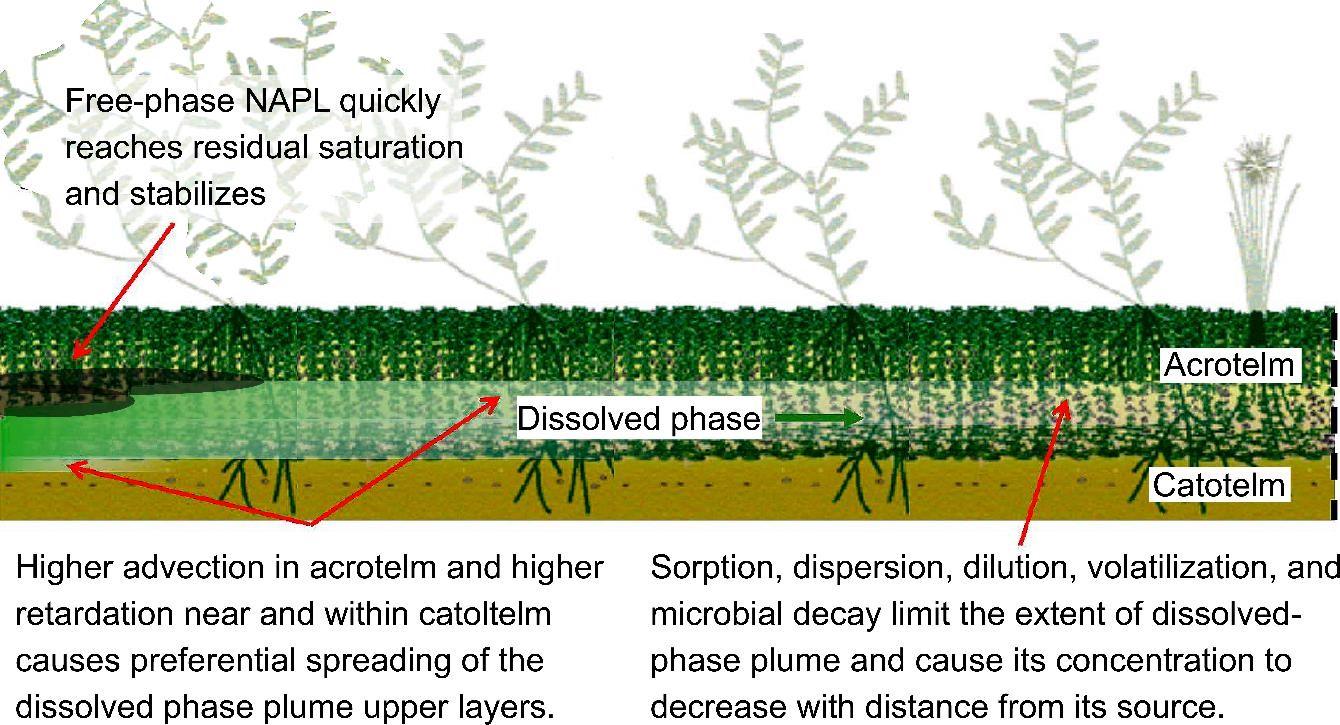5.3 Non-Aqueous Phase Liquids (NAPLs)
Up to this point, our descriptions of the transport processes and behavior of contaminants have been directed at water soluble substances. However, non-aqueous phase liquids (NAPLs) have dramatically different transport and reactivity properties, and behave differently in peatlands than in mineral soils. Like most contaminants in peatlands, the likelihood of transport or sequestration of these particular contaminants will depend on the specific peatland type, biological communities, method of introduction (e.g., surface or buried pipelines), and whether it is “lighter” than water (LNAPL, e.g., diesel fuel) or denser than water (DNAPL, e.g., bitumen or chlorinated solvents). While many of the processes governing the migration of NAPLs in groundwater are common to both mineral and peat systems, the chemical and mechanical properties of peat (Table 1) are so different than those of mineral sediments that the fate of NAPLs can be distinctly different.
The wettability of a soil matrix concerns the inclination of a pore fluid (including air, water, and NAPL) to spread over a pore surface in the company of the other fluids. This depends on the surface chemistry of the pore and the wetting history. Dry peat is used as a mopping agent in oil spills on water because the nonpolar hydrocarbon molecules preferentially wet the peat. If water wet, however, the affinity for NAPLs is reduced. The conditional wettability of peat therefore exercises a strong control on the mobility of NAPL.
In a peat soil profile, pores are generally already water wet due to capillary processes. However, the poorly decomposed near surface peat that comprises predominantly large pores drains readily, and the pores become increasingly air wet (more hydrophobic). Deeper, more decomposed peat has a smaller pore size distribution that retains more water; hence, pores may be predominantly water filled and remain water wet. When NAPL is introduced (e.g., a spill), it will preferentially enter the larger pores that are air wet and will be blocked from water filled (water wet) pores that are more prevalent at depth. The consequence of this is that spilled NAPL will preferentially spread in the upper layer and be precluded from entering more decomposed peat at depth. This is true for both LNAPL and DNAPL, although the latter will be more likely to exploit partially water wet pores and move downward through the peat. Gharedaghloo and Price (2017) provide more details of peat wettability and its implication for NAPL transport.
The wetting behavior of a soil controls the capillary—saturation relationship and the relative permeability—saturation relationship, which can be defined for both water and NAPL (Gharedaghloo and Price, 2019). In the presence of NAPL filled pores, water will recede into pore throats, and the low degree of water saturation will correspond with low (more negative) pressures. Simultaneously, the low degree of water saturation will reduce water permeability and water redistribution will be restricted. Conversely, NAPL saturation will be high and relatively more mobile. However, given a spill of finite volume, the spread of NAPL will decrease the NAPL saturation and, simultaneously, the NAPL permeability until the residual saturation level is reached. Thus, after initially spreading rapidly in the upper peat layer, the distribution of NAPL will stabilize, whereupon volatilization, microbial processes, and solubilization will further reduce the NAPL pool. Solutes released from the NAPL will tend to remain near the surface where their mobility and extent is constrained by microbial breakdown (Gupta et al., 2020) and adsorption (Gharedaghloo and Price, 2021), which is high in the organic rich peat matrix (Figure 19).

Figure 19 – Schematic of free-phase NAPL and dissolved phase redistribution through a peatland. There will be preferential spread of the NAPL in the shallow peat horizons until it reaches residual saturation. Soluble components will flow preferentially in the upper layer and their concentration will decrease with distance from the NAPL pool until the dissolved phase plume reaches its maximum extent (Modified from Gharedaghloo and Price, 2017).
